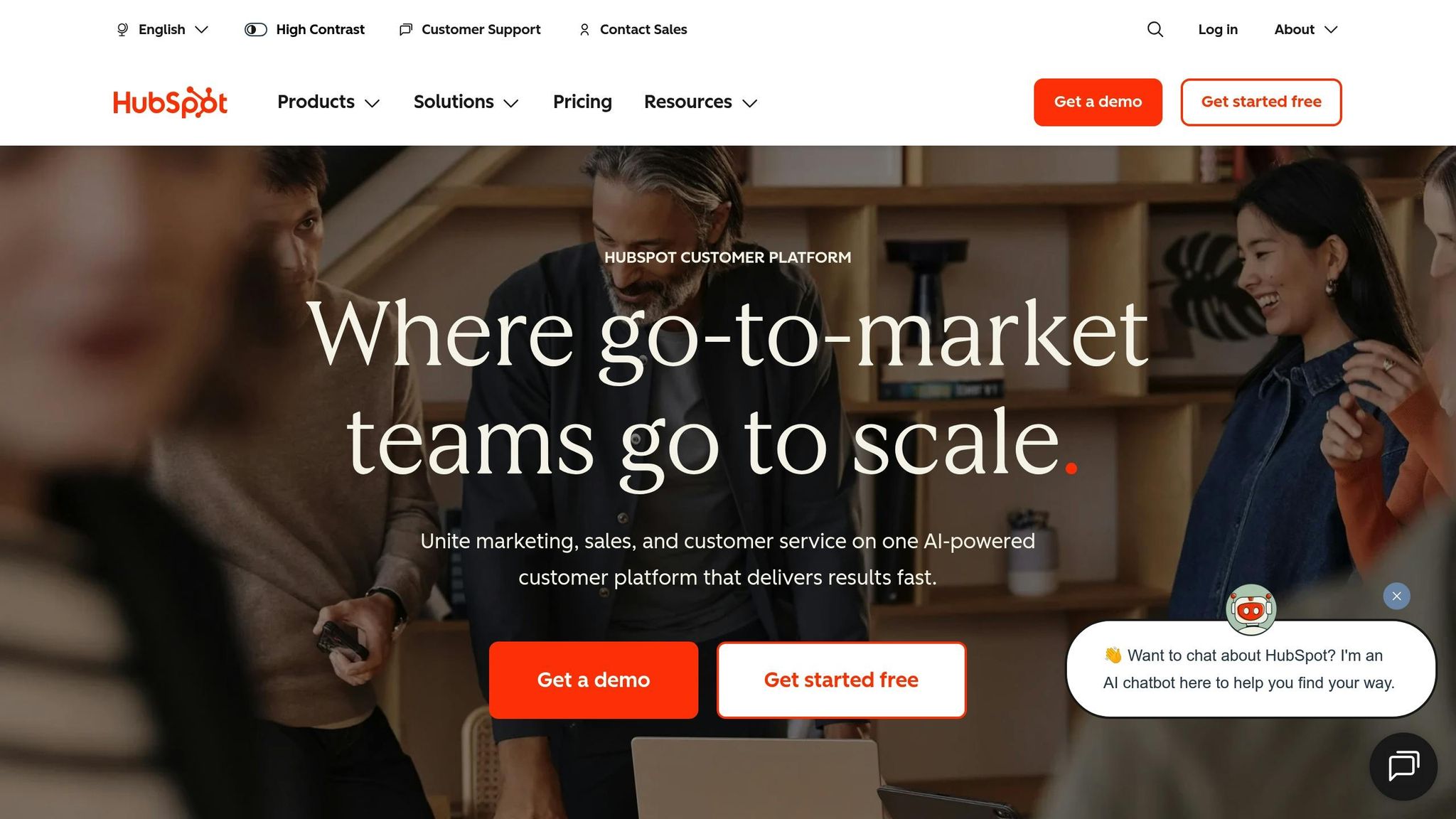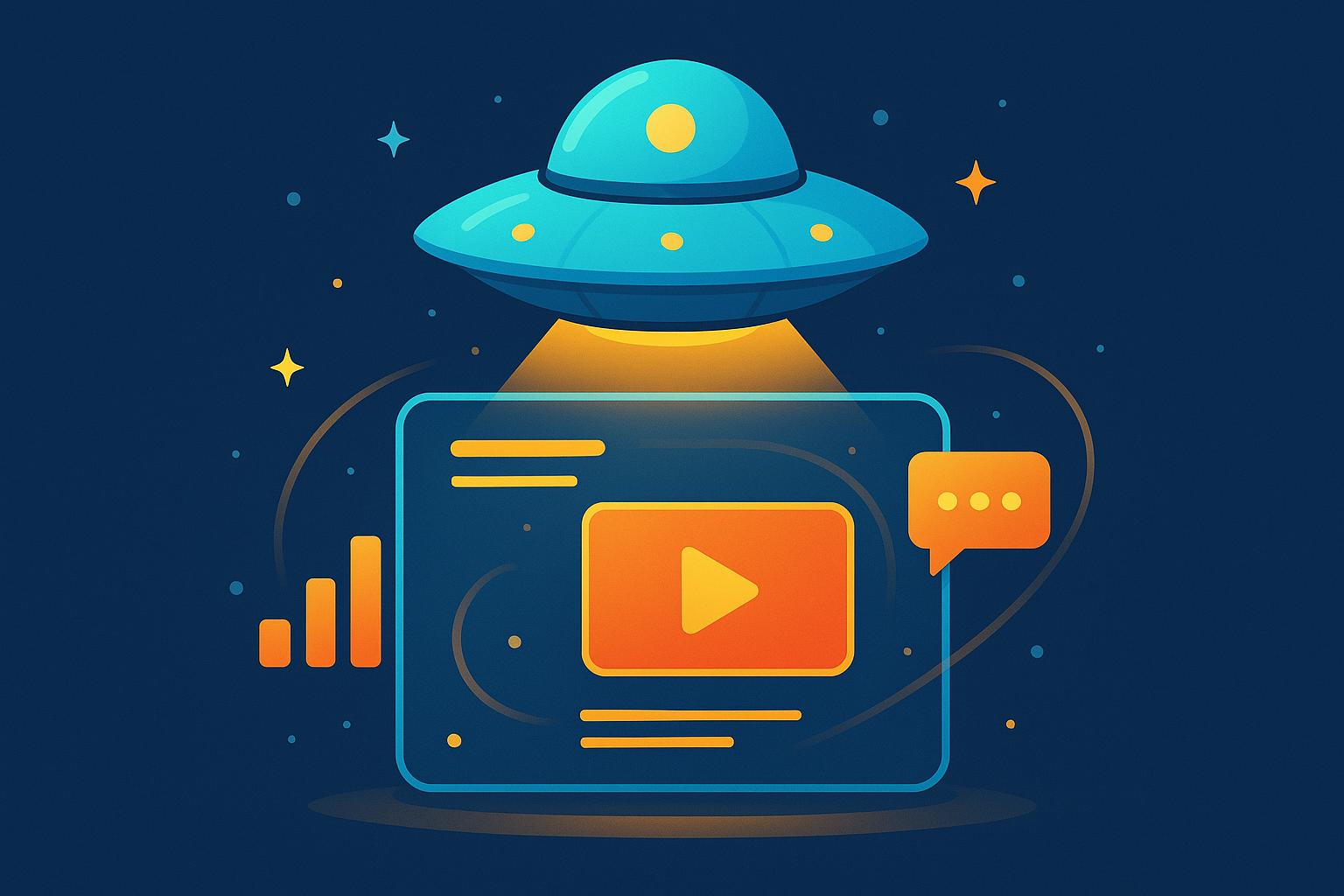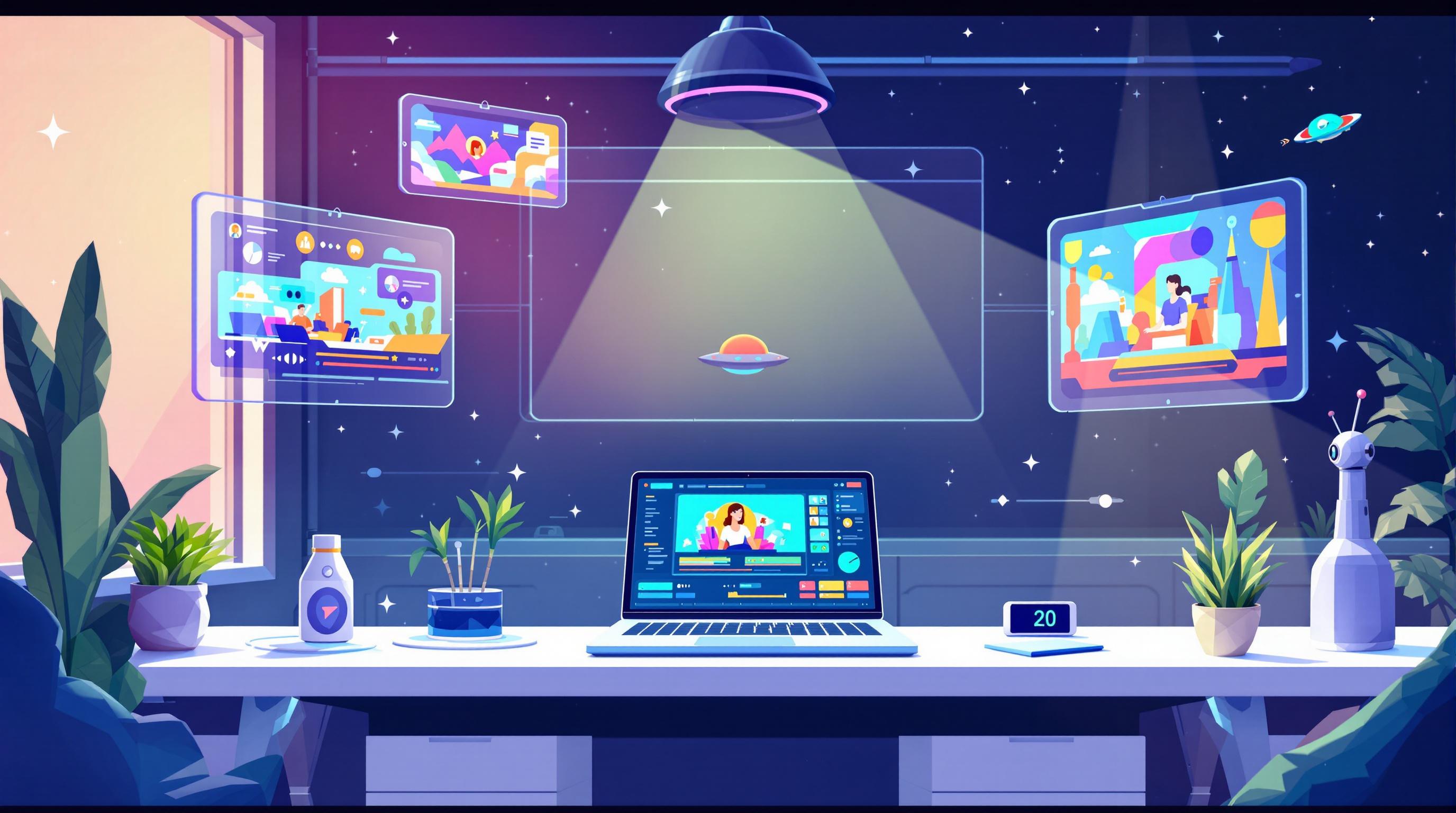AI video tools are transforming marketing in 2025, making video production faster, cheaper, and more accessible for businesses of all sizes. Here's what you need to know:
- Why AI Videos Are Essential: The demand for video content is higher than ever, but traditional production is costly and slow. AI tools automate video creation, saving time and money.
- Key Trends:
- Personalized Content: AI allows businesses to create tailored videos for different audience segments.
- Short-Form Videos: Platforms like TikTok and Instagram favor quick, engaging clips.
- Interactive & Shoppable Features: Videos now let viewers shop or interact directly within the content.
- Better Campaign Results: AI videos improve engagement and conversions while speeding up content production.
- Platform-Specific Formats: AI simplifies adapting videos for platforms like Instagram, LinkedIn, and YouTube, ensuring consistency across channels.
AI tools like Paracast.io let marketers create professional-quality videos for as little as $3, using templates and custom branding. Whether you're a startup or a large business, integrating AI videos into your strategy can help you stay competitive in today's fast-paced marketing landscape.
7 AI Marketing Trends That Will Transform Your Business in 2025 | HubSpot Report

Top AI Video Trends in Multi-Channel Marketing for 2025
The world of AI video is changing fast, redefining how marketers design and execute multi-channel campaigns. These advancements are making video marketing more precise, engaging, and easier to scale. Let’s dive into how trends like personalized content, short-form videos, and interactive features are setting the stage for 2025 marketing strategies.
Personalized Video Content at Scale
Personalization has become the cornerstone of effective video marketing. Thanks to AI, brands can now create multiple tailored video versions from a single template, using audience data to fine-tune messaging.
This strategy ensures that content feels relevant without breaking the budget. AI tools can tweak visuals, calls-to-action, and even the tone of the message to suit different audience segments, leading to stronger engagement.
Take tools like Paracast.io, for instance. They allow marketers to generate customized versions of a single product demo or announcement. A SaaS company, for example, could create one video emphasizing productivity for enterprise clients and another focusing on affordability for small businesses - all while leveraging one original template.
The Rise of Short-Form Video
Short-form videos have become the go-to format for grabbing attention on social media. Platforms are flooded with quick, dynamic clips that deliver their message in seconds, catering to audiences who prefer fast, engaging content.
This shift has forced marketers to rethink their strategies, focusing on condensing key messages into easily digestible formats. AI-powered tools now provide templates designed specifically for short-form content and can automatically reformat videos to fit platform requirements, such as vertical layouts for mobile-first audiences.
Interactive and Shoppable Video Features
Interactive videos are transforming passive viewers into active participants. These features let audiences click, explore, and even shop directly within the video, creating a seamless path from interest to purchase.
Shoppable video technology has advanced significantly, with AI now capable of identifying products within a video and embedding purchase links directly into the content. This makes it easier for viewers to act on their interest without leaving the video.
Beyond shopping, interactive elements like polls, quizzes, and clickable hotspots boost engagement and provide valuable audience insights. This real-time data helps marketers refine their strategies, ensuring that campaigns remain consistent and effective across all channels.
Performance Data: How AI Videos Improve Campaign Results
The numbers don’t lie - AI videos are making waves in marketing campaigns. Businesses across various sectors are seeing measurable improvements in key metrics when they incorporate AI-generated videos into their multi-channel strategies. These results are prompting more marketers to embrace AI-powered video tools as a cornerstone of their campaigns.
Better Engagement and Conversion Rates
AI videos are proving to be a game-changer for grabbing attention and driving interaction. Compared to traditional formats, they consistently boost audience engagement. Why? It’s all about the enhanced visuals, pacing, and messaging that AI tools bring to the table. On top of that, personalized video content - tailored to specific audience segments - has been shown to improve conversions and strengthen brand awareness. This aligns with the growing preference for interactive and customized content.
Faster Content Production
One of the standout advantages of AI video tools is how quickly they can produce content. Traditional video production often takes a lot of time and resources, but AI-powered solutions simplify the process. Marketing teams can now create high-quality videos at a fraction of the time it used to take, which means they can respond faster to market trends and update campaign messaging in real-time.
These tools also offer automated formatting and ready-made templates to ensure a consistent look across platforms. Take Paracast.io, for instance - it provides pre-designed templates that make video creation both fast and cost-effective. This efficiency not only reduces production costs but also frees up resources for strategic planning and fine-tuning campaigns.
sbb-itb-5bfa442
How to Use AI Videos for Brand Awareness
AI videos are changing the game when it comes to building brand awareness. By blending efficiency with polished branding, they provide a way to connect with audiences across multiple platforms while maintaining a consistent and professional image.
Using Pre-Made Templates for Consistent Branding
Consistency in branding is key to making a lasting impression. Pre-made templates ensure your videos maintain the same look and feel - whether it's the visual style, color scheme, or tone of your messaging. With templates, your logo placement, font choices, and color palette stay uniform across all platforms, reinforcing brand recognition over time.
Take Paracast.io, for example. They offer templates tailored for various business needs, like product demos or milestone announcements. These templates allow you to input your brand elements - colors, fonts, and logo - once and reuse them for future projects. This not only saves time but also guarantees that every video aligns with your brand guidelines.
For startups or small teams, templates are a lifesaver. They let you produce professional-quality videos without needing an in-house design team or a big budget. You get polished content that reflects your brand identity, minus the hassle of learning complex design tools or hiring outside help.
Now, let’s dive into how AI can turn product demos and announcements into compelling content.
Creating Product Demos and Announcements with AI
Product demos and company announcements are perfect opportunities to showcase your brand’s personality while delivering useful information. AI video tools make this process seamless, turning basic product details into visually engaging content that highlights real-world benefits.
Here’s the best part: AI tools can create multiple versions of the same demo, each tailored to different audience segments or use cases. This adaptability extends to announcement videos, which can strengthen your connection with your audience by keeping them in the loop.
Announcement videos are especially effective for building brand awareness. Whether you’re sharing news about a new feature, a partnership, or a company milestone, these videos invite your audience to celebrate alongside you. They add a human touch to your brand, fostering emotional connections.
Paracast.io offers templates specifically designed for announcement videos, covering everything from new feature rollouts to funding updates and team expansions. These templates are crafted to boost engagement while maintaining a polished, professional appearance.
The speed of AI video production is another big advantage. For time-sensitive updates, you can create and share announcement videos within hours, ensuring your audience hears the news directly from you instead of through third parties.
Growing Social Media Reach with AI Videos
Video content consistently performs well across all major social media platforms, but each platform has its own quirks. AI videos make it easier to create content tailored to each channel without adding to your workload.
For platforms like Instagram and TikTok, short-form vertical videos work best. These should feature eye-catching visuals, bold text overlays, and dynamic transitions. LinkedIn, on the other hand, favors professional, informative videos that share industry insights or company updates. For Facebook and YouTube, you have more flexibility to produce longer-form content, such as detailed product demos or educational pieces.
A smart strategy is to create a master video and tweak it for each platform by adjusting the format, length, and tone. This way, you maximize your reach without stretching your resources too thin.
Consistency is still crucial, even when you’re tailoring content for different platforms. Your brand voice, visual elements, and messaging should feel familiar no matter where your audience encounters your videos. AI tools make this easier by letting you apply the same templates and styling across all your content, ensuring your brand remains instantly recognizable.
Adding AI Videos to Multi-Channel Campaigns
Integrating AI videos into a multi-channel campaign requires a thoughtful approach. The key is aligning each video's format with the specific platform while staying true to your brand's core message. By doing so, you can amplify your campaign's impact and reach.
Matching Video Formats to Each Platform
Each platform has its own style and audience preferences, so understanding these nuances is crucial for optimizing your AI videos.
- Instagram: Vertical videos (9:16) are ideal, especially for Stories and Reels. Keep them under 60 seconds and grab attention within the first three seconds using eye-catching visuals. Authentic, behind-the-scenes content often performs better here than overly polished productions.
- Facebook: Both square (1:1) and horizontal (16:9) formats work well. While longer videos are allowed, engagement tends to drop after two minutes. Adding captions to spark conversations can further enhance performance.
- YouTube: This platform is built for longer videos, with horizontal 16:9 being the preferred format. Whether it's a short 30-second ad or an in-depth 10-minute tutorial, content that keeps viewers engaged is rewarded.
- LinkedIn: Professional and informative videos work best, either in square or horizontal formats. Videos between 30 seconds and two minutes that provide industry insights, company updates, or educational value resonate with LinkedIn's audience.
- Email Campaigns: Use a video thumbnail that links to hosted content. Since many email clients don’t auto-play videos, a compelling thumbnail with a clear play button is essential. Keep file sizes small to ensure smooth delivery.
Tools like Paracast.io simplify the process of adapting video formats for multiple platforms. With it, you can create a master video and generate platform-specific versions effortlessly, saving time while maintaining quality.
Keeping Messages Consistent Across Channels
Consistency doesn’t mean repeating the same content everywhere. Instead, it’s about maintaining your brand's identity - logo placement, color schemes, typography - while tailoring your message and tone for each platform.
Your core message should remain intact but adapted to fit the platform. For example, a product announcement might highlight user experience with quick visuals on Instagram, while on LinkedIn, it could focus on business benefits and ROI.
Tone adjustment is equally important. You might opt for a professional and authoritative voice on LinkedIn, a casual and friendly tone on Facebook, and a trendy, energetic style on Instagram or TikTok. The personality of your brand stays consistent, but the way you express it shifts to meet audience expectations.
Using a content calendar and organizing videos around specific themes can help ensure that all content - while tailored - works together to reinforce your campaign's main objectives. This approach avoids audience fatigue while keeping your messaging cohesive.
Measuring and Improving Campaign Performance
Evaluating success goes beyond counting views and likes. A deeper analysis of how your videos perform across channels is essential.
To get a complete picture, combine methods like Marketing Mix Modeling (MMM), Multi-Touch Attribution (MTA), and Incrementality Testing. These tools provide insights into how each video contributes to your overall strategy.
Here are key metrics to track:
- Engagement Depth: Analyze how long viewers watch, where they pause, and which parts they replay. This data helps refine your content for better engagement.
- Cross-Channel Attribution: Determine which videos drive traffic to other platforms or lead to conversions in different parts of your marketing funnel.
- Predictive Performance: Use AI analytics to forecast video performance and make real-time adjustments. This shifts your strategy from reactive to proactive, allowing you to optimize campaigns as they run.
- Conversion Tracking: Link video views to tangible outcomes like sign-ups, purchases, or demo requests to measure ROI accurately.
Research shows that AI-driven analytics can improve decision-making speed by 78%, while predictive analytics boost forecasting accuracy by 47%. These capabilities let you fine-tune campaigns on the fly, rather than waiting for post-campaign results.
However, 66% of marketers worldwide admit they lack confidence in their data and analytics systems. Investing in a solid technical foundation, such as a Customer Data Platform (CDP) that unifies data across channels, is essential for leveraging advanced analytics and delivering personalized marketing.
Regular performance reviews should focus on actionable insights. Instead of just looking at past results, identify specific ways to improve. This might mean tweaking your content strategy, reallocating budgets, or adjusting targeting to reach the right audience with the right message. By continuously refining your approach, you can ensure your campaigns remain impactful and effective.
Conclusion: What's Next for AI Videos in Marketing
AI videos are shaping up to be a game-changer for marketing strategies in 2025. The numbers are clear - AI-powered videos drive higher engagement, streamline production processes, and deliver better ROI. Leveraging these tools isn't just a nice-to-have anymore; it's becoming essential for staying ahead in the competitive landscape.
As audiences increasingly expect personalized and interactive content, the days of generic, one-size-fits-all videos are fading fast. Businesses need to pivot toward creating content that resonates on a deeper level, addressing specific needs and preferences. This shift isn't just about keeping up - it's about meeting audiences where they are and delivering what they truly value.
For startups, agencies, and smaller teams, creating professional-quality video content is now more accessible than ever. Platforms like Paracast.io simplify the process, allowing users to generate sleek promotional videos straight from a website URL. With customizable templates for everything from product demos to partnership announcements, businesses can ensure their branding stays consistent while tailoring content for various platforms.
Whether you're crafting vertical videos for Instagram Stories, polished clips for LinkedIn, or interactive content for Facebook, the ability to produce and test different formats quickly is critical. This agility not only improves campaign performance but also allows businesses to adapt to changing trends and audience behaviors in real time.
Looking ahead, we can anticipate even more advanced personalization options, richer interactive features, and seamless integration between video content and e-commerce platforms. Companies that begin building these capabilities now will be in the best position to thrive as these trends take hold.
The question is: Are you ready to tap into the power of AI-driven video and transform your marketing strategy?
FAQs
How can AI video tools help small businesses save time and reduce costs in video production?
AI video tools have transformed video production for small businesses, making it faster and far more affordable. Traditional video production can run anywhere from $800 to $10,000 per minute - a steep price for many small teams. In contrast, AI-powered tools bring those costs down to just a few dollars per video. Even better, businesses can produce multiple videos in minutes, often spending less than $20 a month to create professional-quality content.
These tools also save time by automating labor-intensive tasks like editing and animation. In fact, production times can be reduced by as much as 80%. For small teams working with tight budgets, this means video marketing is now within reach - scalable, efficient, and budget-friendly.
What are the main advantages of using personalized and interactive videos in multi-channel marketing?
Personalized and interactive videos have the power to make multi-channel marketing campaigns far more engaging. By customizing content to match individual preferences and encouraging viewers to actively participate, these videos leave a lasting impression.
This strategy boosts conversion rates, enhances brand storytelling, and delivers useful data that can fine-tune future campaigns. Beyond grabbing attention, it fosters deeper connections with your audience, leading to stronger performance across all marketing channels.
How can marketers create AI-generated videos that work well across different social media platforms while staying true to their brand?
To get the most out of AI-generated videos on social media, it’s essential to customize key elements like video dimensions, captions, and visuals to fit each platform’s specific needs and audience habits. For instance, vertical videos tend to shine on Instagram and TikTok, while longer horizontal formats are a better fit for YouTube.
AI tools that adjust videos for different platforms can be a huge time-saver and help maintain a consistent style. It’s also important to ensure that every video reflects your brand’s voice, tone, and visual style. This consistency not only strengthens brand recognition but also boosts engagement across all platforms.


